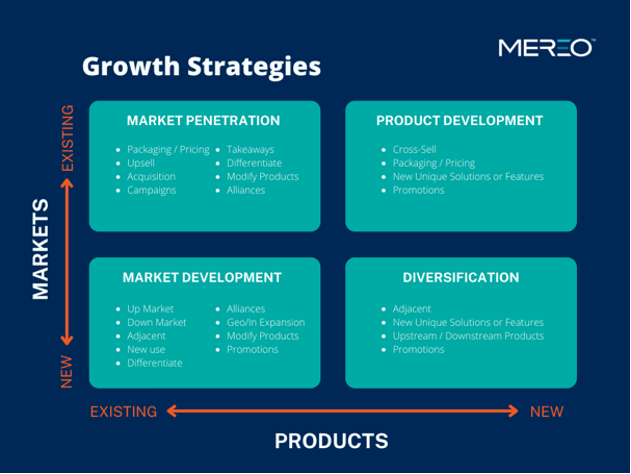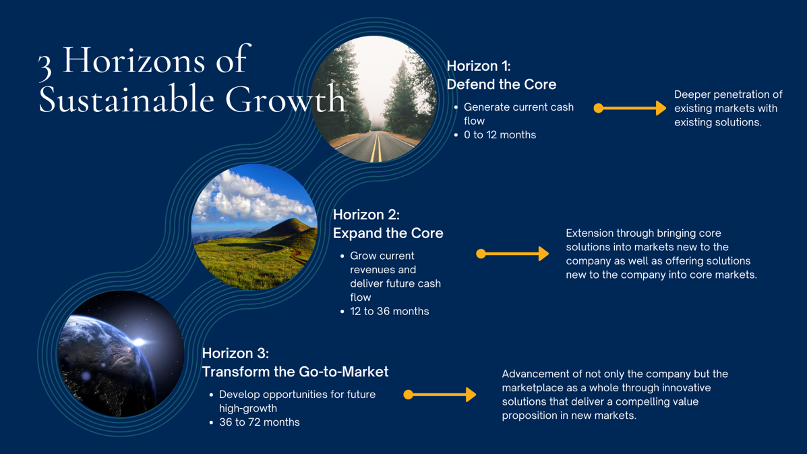The kids may be off for the summer and living the life of leisure, but now is not the time for your product team to kick back poolside. Now is the time for your product management and product marketing leadership to set the stage for next year’s strategic annual plan. And we have a challenge to share with you — a summer break assignment if you will — to help focus your efforts.
Gather your team, poolside even if you prefer (just mind the electronics near the water), and get ahead of the planning period with some back-to-basics portfolio analysis planning. If you are up for the challenge, that is.
3 PRODUCT PORTFOLIO ANALYSIS ASSIGNMENTS TO JUMPSTART YOUR ANNUAL STRATEGIC PLANNING
1) Brainstorm Growth Opportunities
You likely recognize this as a version of the Ansoff Matrix. And it is true: The Mereo Growth Strategies Matrix tool is nothing new and revolutionary. It has actually been around since 1957. Yet, we use it because it works. And I share it here because most B2B organizations do not have a leader that drives this thought process. Without a dedicated portfolio management group, an organization lacks anyone tasked with stepping back from the day-to-day who can envision how years of efforts and investments can be optimized and aligned for growth.
One of the most challenging realities for product management and marketing leaders is that while every organization wants to grow, not every organization is going to develop a new product year after year. So, how do you grow then? The matrix offers a common sense but not common practice map forward in your product portfolio analysis.
With existing products, you have two paths to growth. In both options, your team must re-envision how you can modify your existing product for either a current market or a new market. Maybe you change the packaging and pricing to make the solution more appealing. Or perhaps you have to get more creative in how you market it, differentiate it, sell it.
If your company is in the rarer situation of building something new, you have to plan for the investments. With a new product in a completely new market, your organization will face steeper investment costs. Even in an existing market, your team still has to engineer something new, test it, package it and so much more. Think through how long product development will take to go-to-market successfully.
RECAP: Key growth planning steps to take this summer:
- Turn to the Mereo Growth Strategies Matrix tool.
- Brainstorm growth ideas with your product team, taking into consideration investment costs and time to market.
- Hang on to all growth ideas for your next summer portfolio analysis assignment.
2) Revisit Your Horizon Plan
Once your team has thought through growth strategies, be careful with excluding ideas that do not make the next-year cut. Think about the ideas with a longer-term planning outlook and see how they could fit into different time horizons of your growth strategy.
When could you act on a product strategy? Horizon one (0-12 months), two (12-36 months) or three (36-72 months)? How fast can your team feasibly see an idea through? Leverage the inputs from your planning activity to build out a longer-term plan toward sustainable revenue performance.
RECAP: Key horizon planning steps to take this summer:
- Compile your growth opportunity ideas.
- Map out ideas on different time horizons.
- Let go of those ideas that do not make the cut for now or into the future.
- Make a note to revisit your horizon plan at least annually.
3) Perform a High-Level Pressure Test
Once you have solid ideas in the mix to work with, how do you validate them? How can your teams take a truly critical and objective look at their feasibility of seeing them through or how the ideas align with the internal strategy? How can you get an impression of how your target buyers will embrace the new product or an existing product’s modifications? Change, while key to growth, demands time and resources. It is vital your teams are making the wisest investment decisions by putting them through a pressure test. The struggle is having means of validation, though. At Mereo, we have developed a number of tools to help validate your strategic plans.
This summer, focus on these validation approaches:
- Score your capability and alignments:
- Financial Benefit in 202x: The potential revenue and margin contribution of the capability are significant enough to justify this level of investment by the company.
- Ability to Deliver: Adjacent products that are part of the solution are technologically proven and well-integrated, and the company and/or partners have the resources/qualified staff to deliver on the customer promise.
- Strategic Importance to the Customer: The solution addresses the strategic business imperative or initiative of the customer.
- Short-term Financial Benefits to the Customer: Your customer has budget and can achieve financial benefits in a relatively short time frame (1-3 years).
- Ability of Sales and Channel Partners to Sell the Solution: The value messaging and domain knowledge is straightforward and clear enough for the sales team to effectively sell the offering with proper training and tools.
- Market Impact: The offering has the potential to reposition the company in the marketplace and/or change the competitive landscape. Plus, it can be supported by a compelling integrated marketing campaign.
- Rate your business competencies from low to high, and be honest about what is feasible for your organization to take on.
- Consider the impact new products or modifications will make on your differentiation.
- Get outside input from a client advisory board.
GET THE ULTIMATE GUIDE TO SOLUTION MANAGEMENT SUCCESS
Along with performing essential product portfolio analysis, uncover the comprehensive solution management practices leading B2B organizations follow. Download the expert guide today.


